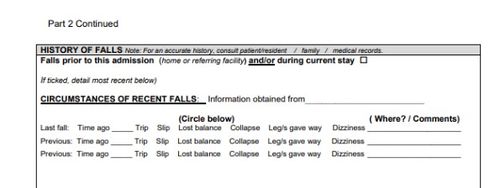The 6-Minute Rule for Dementia Fall Risk
Table of ContentsHow Dementia Fall Risk can Save You Time, Stress, and Money.Some Known Incorrect Statements About Dementia Fall Risk The Basic Principles Of Dementia Fall Risk Indicators on Dementia Fall Risk You Need To Know7 Simple Techniques For Dementia Fall Risk
Assessing loss risk assists the whole medical care group establish a more secure atmosphere for every person. Guarantee that there is a marked area in your clinical charting system where team can document/reference scores and document pertinent notes connected to drop prevention. The Johns Hopkins Fall Threat Assessment Tool is one of lots of devices your staff can utilize to assist prevent adverse clinical events.Client drops in medical facilities are usual and devastating negative occasions that continue despite years of effort to lessen them. Improving interaction across the evaluating registered nurse, care team, client, and individual's most involved family and friends might strengthen loss prevention efforts. A group at Brigham and Female's Health center in Boston, Massachusetts, looked for to establish a standardized fall avoidance program that centered around improved interaction and person and family interaction.

The advancement group stressed that successful implementation relies on patient and personnel buy-in, integration of the program into existing process, and fidelity to program procedures. The team kept in mind that they are grappling with just how to guarantee continuity in program application throughout durations of crisis. During the COVID-19 pandemic, for example, a boost in inpatient falls was associated with restrictions in patient engagement along with constraints on visitation.
Dementia Fall Risk for Dummies
These incidents are typically considered preventable. To execute the intervention, companies need the following: Accessibility to Loss pointers sources Loss suggestions training and re-training for nursing and non-nursing team, including brand-new nurses Nursing workflows that permit patient and household engagement to conduct the falls evaluation, ensure use of the prevention plan, and carry out patient-level audits.
The results can be very damaging, often accelerating client decrease and causing longer medical facility stays. One research estimated keeps increased an added 12 in-patient days after a person loss. The Autumn TIPS Program is based on interesting clients and their family/loved ones across three major procedures: evaluation, customized preventative treatments, and bookkeeping to make certain that patients are participated in the three-step autumn avoidance procedure.
The individual evaluation is based on the Morse Loss Scale, which is a verified autumn danger analysis tool for in-patient healthcare facility settings. The range consists of the 6 most usual factors clients in hospitals drop: the patient loss history, risky problems (including polypharmacy), usage of IVs and other outside tools, psychological condition, stride, and wheelchair.
Each risk factor links with one or more actionable evidence-based treatments. The registered nurse produces a plan that includes the interventions and is noticeable to the treatment group, client, and family on a laminated poster or printed visual help. Registered nurses establish the strategy while satisfying with the person and the patient's family members.
Some Known Details About Dementia Fall Risk
The poster acts as an interaction device with other participants of the client's care team. Dementia Fall Risk. The audit element of the program includes analyzing the individual's expertise of their danger variables and avoidance plan at the unit and hospital levels. Registered nurse champions perform a minimum of 5 specific meetings a month with people and their family members to inspect for understanding of the autumn avoidance strategy

An estimated 30% of these drops result in injuries, which can range in severity. Unlike various other adverse occasions that require a standard medical response, autumn avoidance depends extremely on the needs of the person.
How Dementia Fall Risk can Save You Time, Stress, and Money.

Based upon bookkeeping results, one site had 86% conformity and 2 sites had more than 95% compliance. A cost-benefit analysis of the Loss TIPS program in 8 healthcare facilities approximated that the program price $0.88 per client to carry out and resulted in cost savings of $8,500 per 1000 patient-days in straight costs associated with the avoidance of 567 drops over three years and eight months.
According to the innovation team, organizations curious about implementing the program ought to carry out a preparedness analysis and falls prevention spaces evaluation. 8 In addition, companies should guarantee the necessary facilities and operations for execution and establish an application plan. If one exists, the organization's Autumn Avoidance Job Pressure should be involved in planning.
Dementia Fall Risk - Questions
To start, companies must make certain conclusion of training modules by nurses and nursing aides - Dementia view it now Fall Risk. Hospital team must examine, based on the demands of a medical facility, whether to use a digital health and wellness record hard copy or paper version of the autumn prevention plan. Carrying out teams ought to hire and train nurse champs and establish processes for bookkeeping and reporting on loss data
Staff need to be associated with the process of redesigning the operations to engage people and household in the assessment and avoidance plan process. Equipment ought to remain in location to make sure that systems can understand why a loss occurred and remediate the reason. Much more specifically, registered nurses should have networks to provide continuous feedback to both personnel and device management so they can adjust and boost fall avoidance operations and communicate systemic troubles.